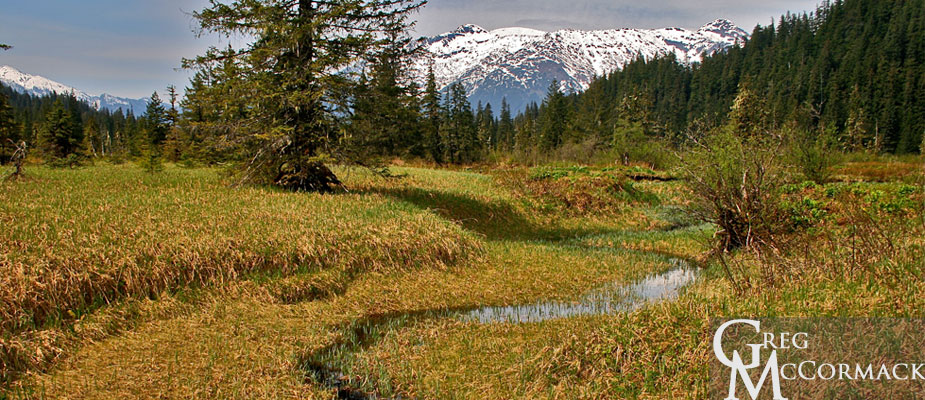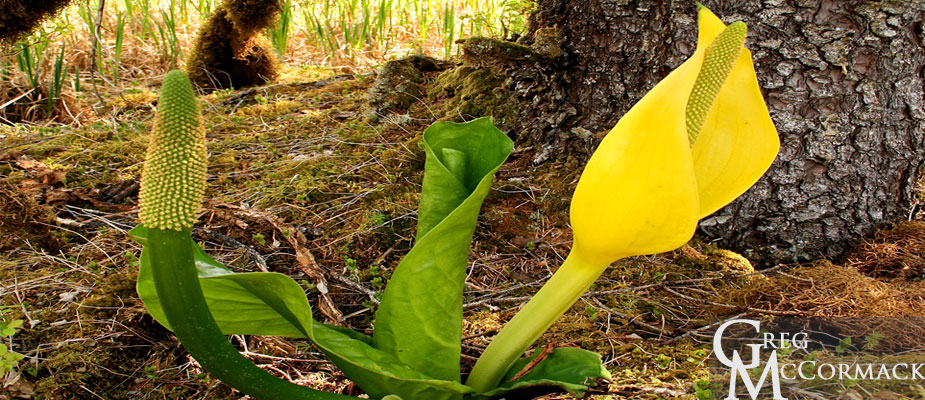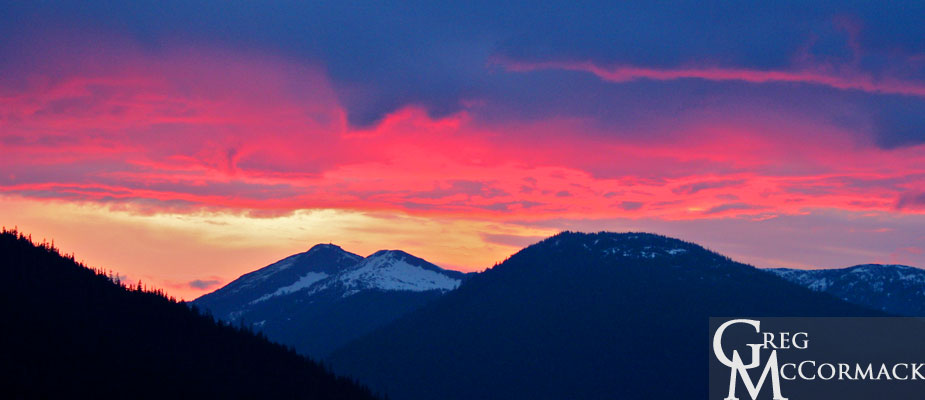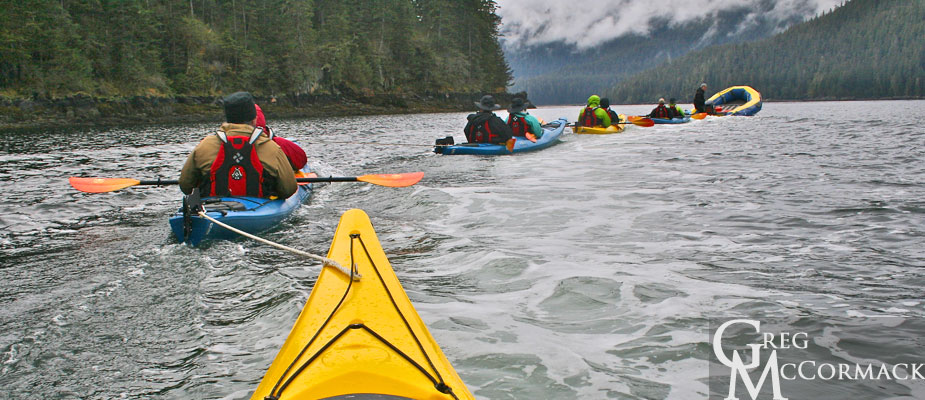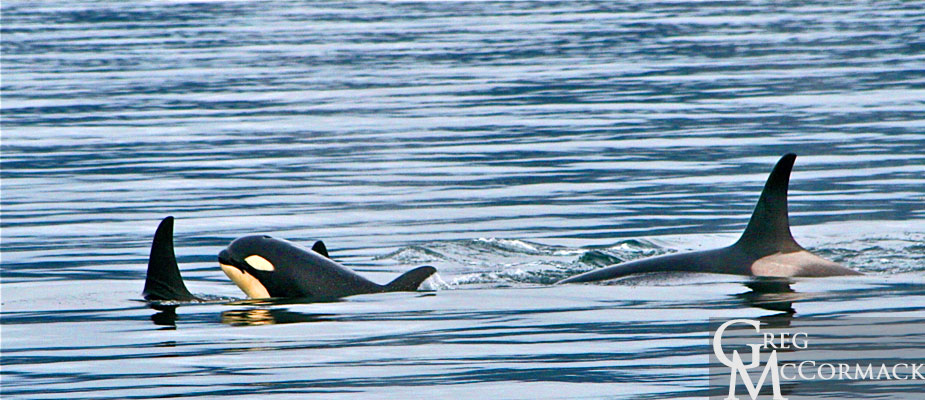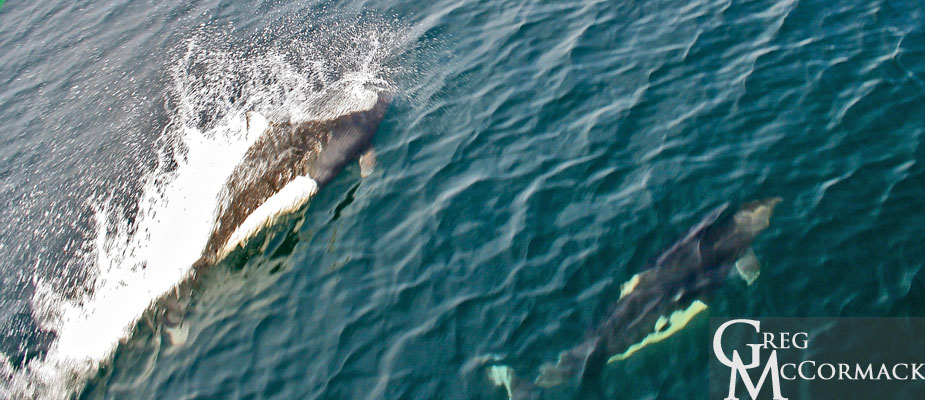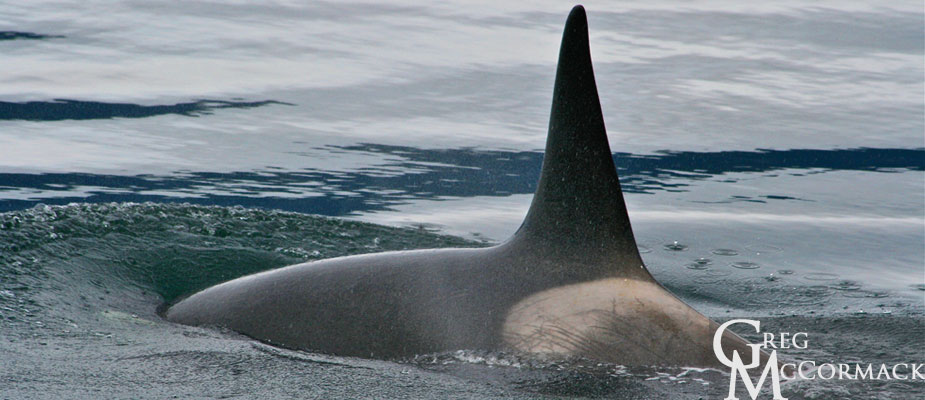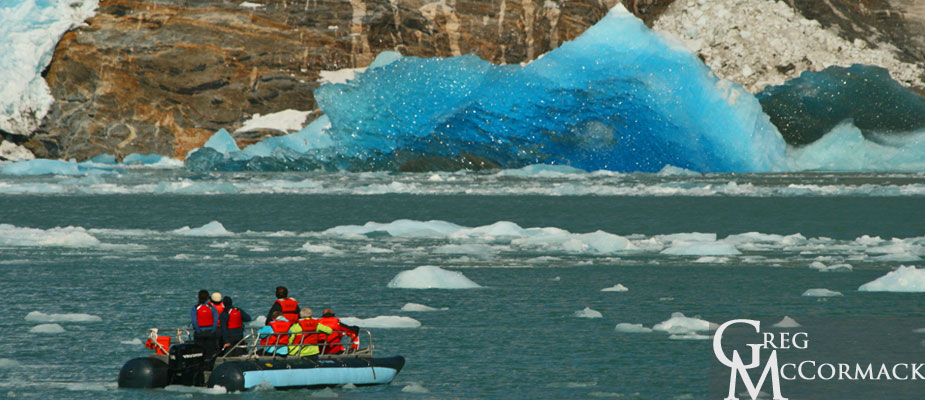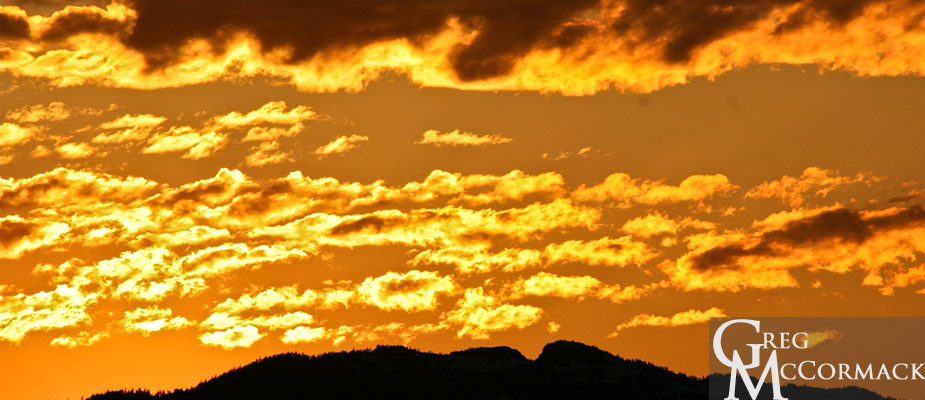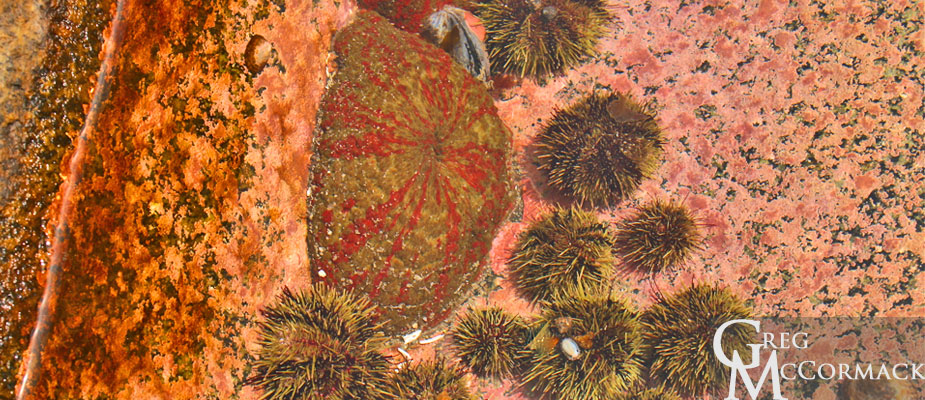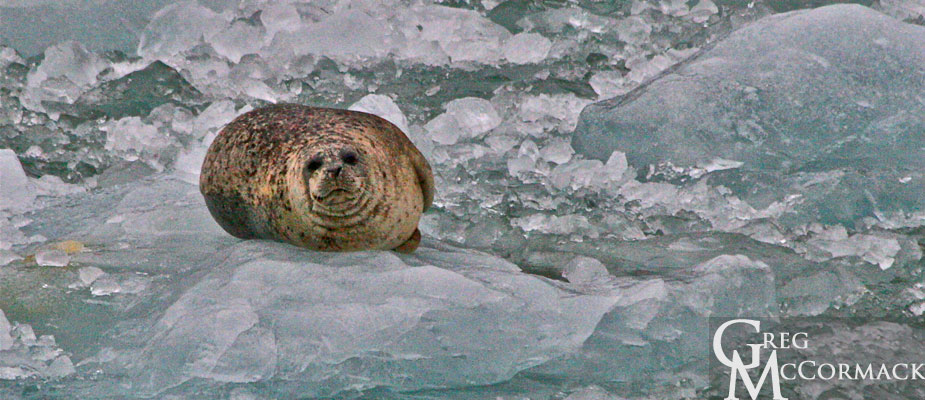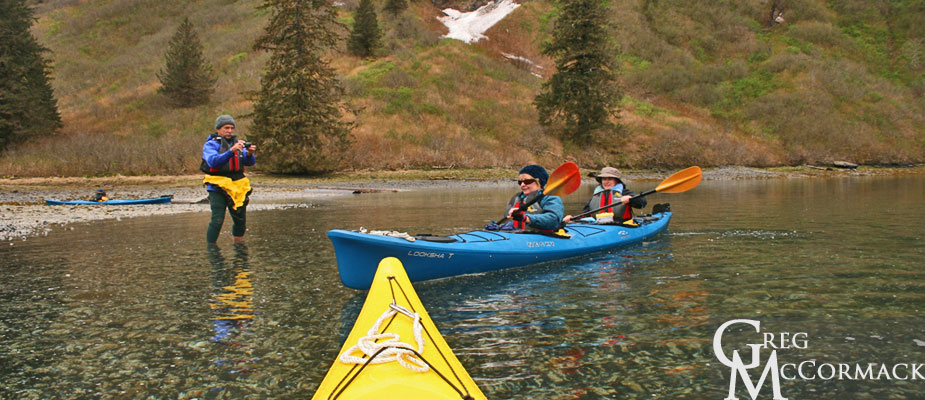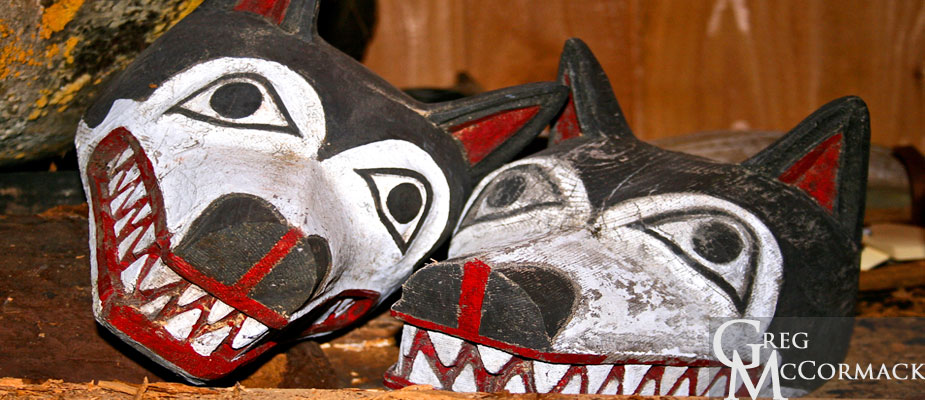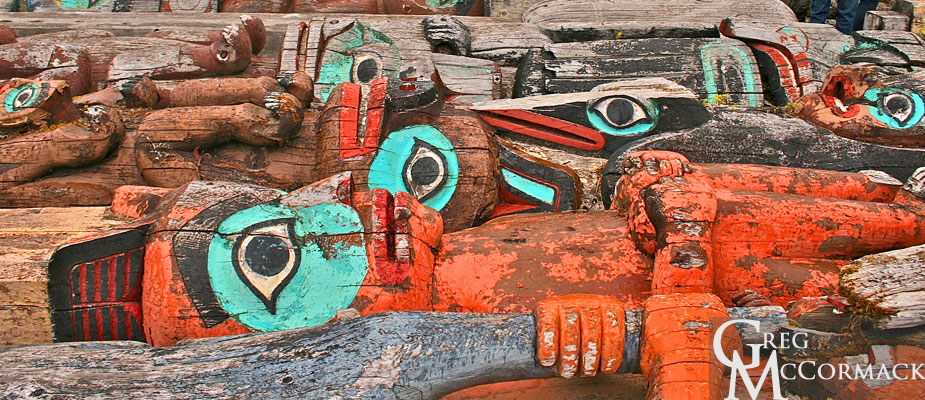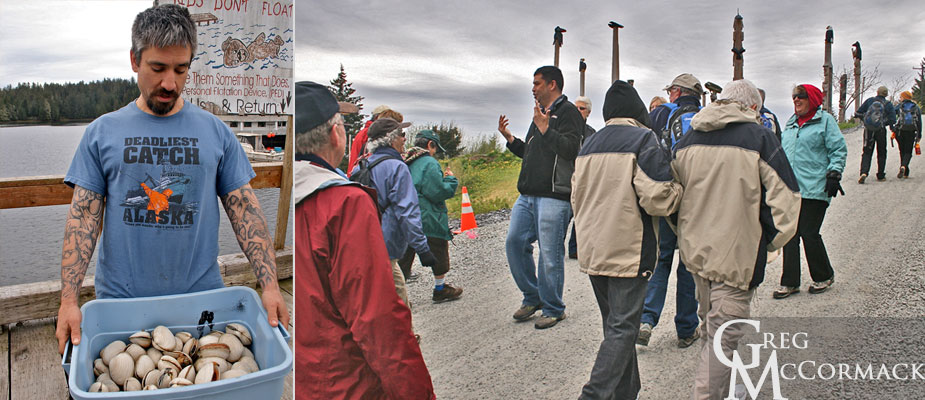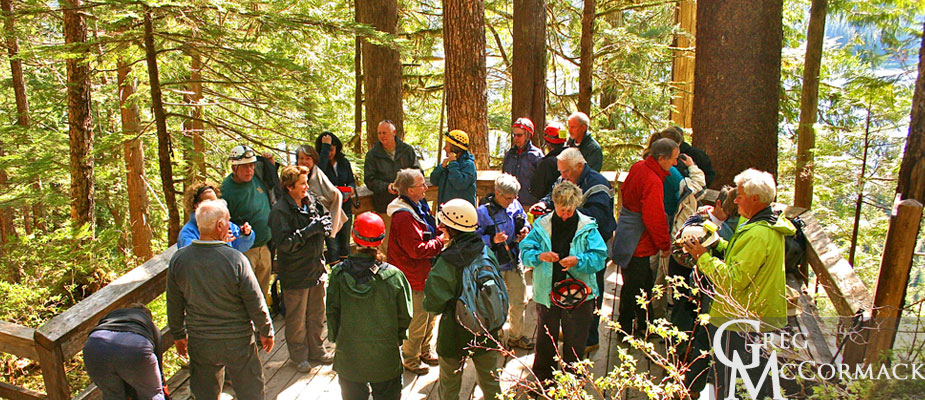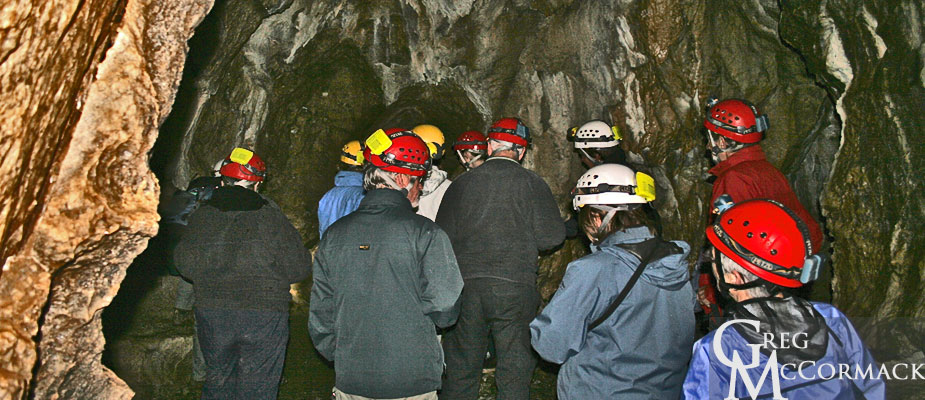Tuesday | May 24th
July 1, 2011 by admin
Filed under InnerSea Discoveries
Wrangell – I love this town! It feels like a western town. Doesn’t have any ticky-tacky tourist shops.
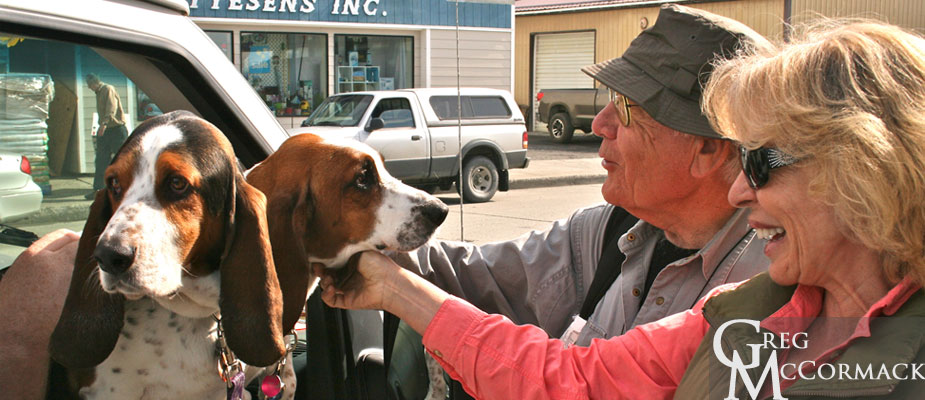
Totems and amazing vocal display of a raven communicating amongst two other ravens on either side of the bay. An eagle right above our heads, song sparrow flitting amongs the emerging vegetation. The cow parsnip is only about 1.5 feet high, in a month it will be 4 feet. The Nolan Center has an incredible bookstore. How many times have I said that Alaska has the best natural and cultural history books than anyplace in the world. The photography is practically second to none.
I met a native of Wrangell, David McHolland, he was born and raised here he sets trap lines for Marten and River Otter and occasionally Wolverine and Wolves. Found out that the Grassy Headlands at the mouth of the Stikine River is a prime stopover on the Pacific flyway for 10,000 Snow Geese, 5,000 Sandhill Crane and has a spring time population of 2,000-5,000 Bald Eagles.
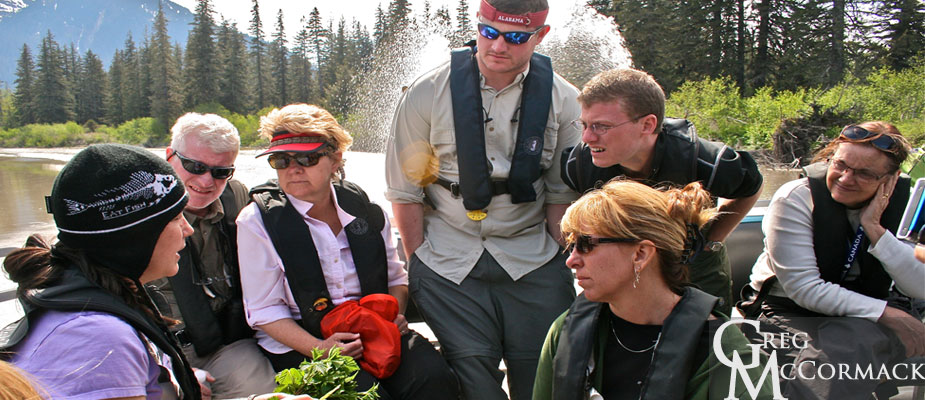
Over 100 glaciers feed into the Stikine river which make the water have it’s muddy tone.
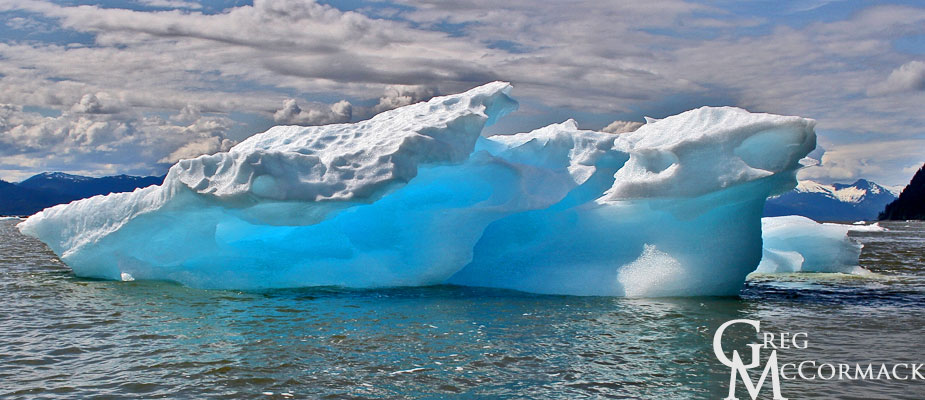
At 3:18p.m. while still going upriver to see the Shakes glacier bergs in a frozen lake (spotted a Mountain Goat), I announce to the jolly crowd: “42 minutes until ‘all aboard’ back at the ship”. We eventually make it back exactly an
hour later. We then cruise by many islands that I have not seen before…experience another dinner on deck with fabulous scenery and engaging conversation with fellow crew members.
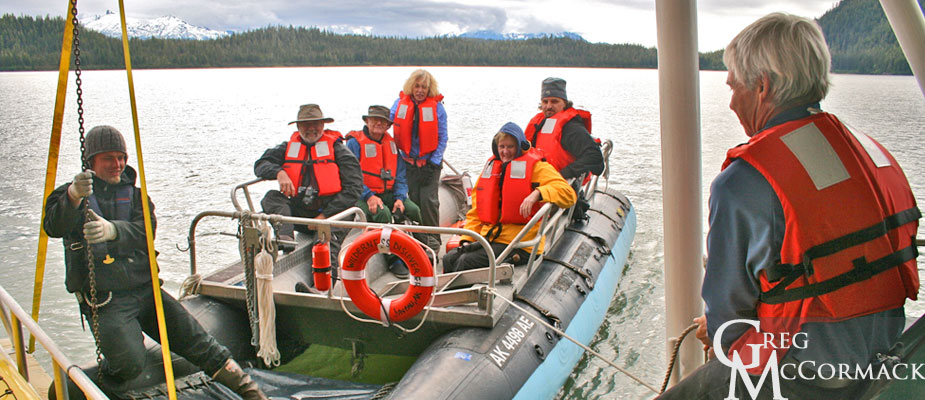
Loved when I heard Randall say: “Another rough day at the office!” to me when we were clearly feeling good and perhaps a tad bit of guilty pleasure about being off of the ship enjoying the scenery with all of the good passenger guests on this excellent shore excursion.
Monday | May 23rd
July 1, 2011 by admin
Filed under InnerSea Discoveries
Up at 5:15am and departing to go ashore at the Baird Glacier by 6:15 a.m. It takes 30 minutes in a cold drizzle to get up the very shallow bay and glacial river to a not-so-steep bank to disembark adventure-seekers. A couple of our boat props were dinged on unseen boulders. In fact, the glacial flour was so thick and in suspension in the water column that visibility was perhaps only 6 inches at best.
Randall scouts the route while I interpret the dynamic landscape in front of the snout of the glacier. “Take your fist and push your stomach in…now release your fist and tell me what happens to your stomach? It rebounds back out. This is an example of what is called isostatic rebound.
Has anyone ever shoveled snow before and found out that snow is heavy? Glaciers are made of snow that has been converted to ice. Ice is a mono-mineral like calcite, so snow can be considered to be “sedimentary” rock whereas the snowball you want to throw at your enemy you add heat and pressure in your hands to turn it into ice, or metamorphosed rock.
Heavy weight has compressed the earth. When the glaciers lose mass, the Earth rebounds at rates of up to 1.5 inches a year or more.
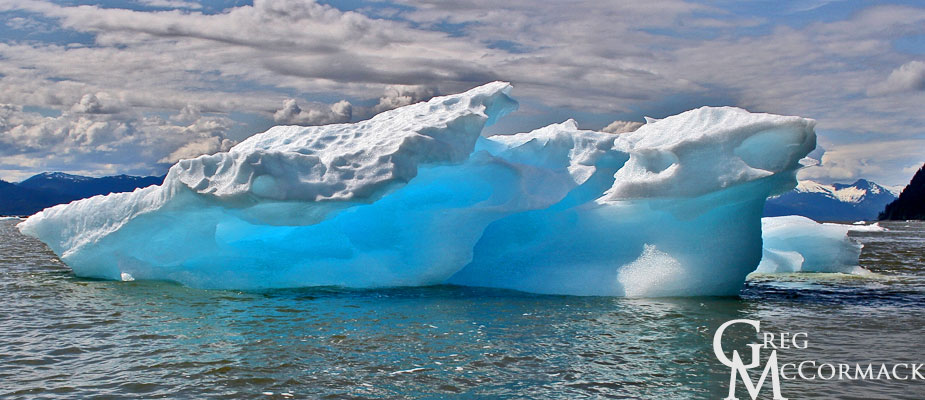
New land is being created and colonized by lichens, mosses, herbs and shrubs like the pioneering mountain avens and alder trees which prepare the soil for the spruce and hemlock.
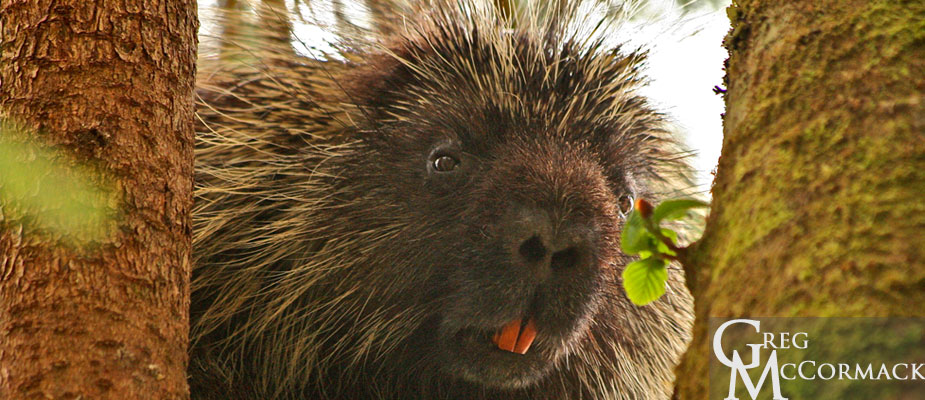
We cross a lunar-like landscape in which we see evidence of “uniformitarianism”, the concept that “the present is the key to the past”. Erosional processes and ablation (melting and wastage) of the Baird glacier was evident as we walked in front of and onto the snout of the glacier over the “push” or terminal moraine. Some of the glacier flour and mud was so thick that “liquefaction” occurred directly under our boots, similar to what hardened Jell-o might feel.
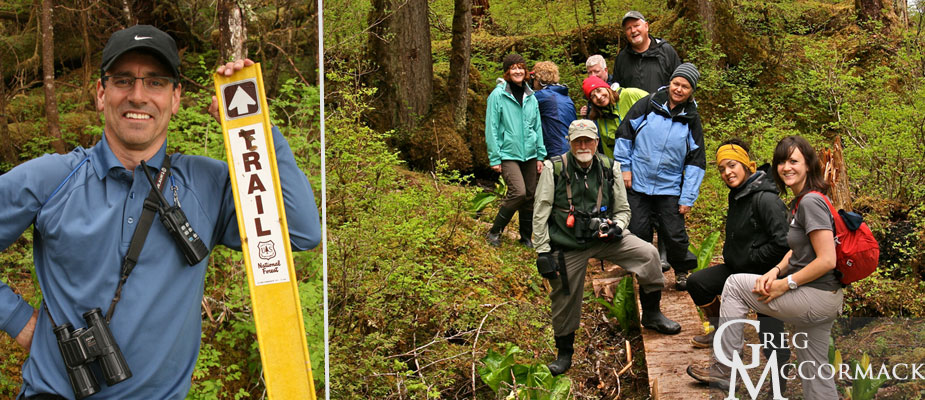
The whole appearance of the moraine is of a giant gravel pit that has been worked over by 1,000 bulldozers moving without any coordination. The out-flow river that came out of the side of the glacier near a lateral moraine sounded like a giant rock-tumbler machine. The granitic rocks were amazingly rounded without any edges, evidence that the material had been worked over many times over the last 3.5 million years during the Pleistocene.
Even before we put on our “yak-tracks” cramp-ons onto our boots it was obvious that great pieces of the glacier had calved off beneath our feet within the matrix of the unconsolidated debris, such as gravels, silts and clays that had been plucked by the glacier upon its descent from the Stickeen Icefield 12 miles up-valley.
Across the outwash plain the long-distance champion migrant Arctic Tern was calling out in raspy notes and flying gracefully and buoyantly upon the lifting mists, their white mantle glistening in sunlight from a deepening blue hole in the once overcast sky.
Sunday | May 22nd
July 1, 2011 by admin
Filed under InnerSea Discoveries
Morning mist and a drizzle does not deter our gung-ho passengers.
We set out to kayak from 7:45 a.m. until 11 a.m. all the way up the bay with a 20 minute stop within the first 75 minutes. Take a 1 hour lunch stop and end up going against the tide again and a pretty big fetch area for the wind to develop white caps. Our going was slowed and folks were visibly feeling like this was a big work-out, so I called and asked for assistance after we put in another 90 minutes.
Bosun Aaron gives us a ride back, which was a blast and saved us from getting back an hour late from our “all aboard time” at 2p.m.
The skies are clear and we have some of the best whale watching ever! One of the local pods (about 30 individuals) of killer whales come alongside our boat. Mothers with newborns were seen alongside the 6-foot tall triangular dorsal fin of the males. All of the guides do a marine mammal interpretive session before conducting a man-overboard drill in which passengers don life-jackets.
Later, our bow camera shows the extraordinary show for 20 minutes of bow-riding Dalls porpoise and right when dinner was called and folks had their appetizer, a repeat of last night where we saw our first humpback only an hour from departure…except this time one of the two whales breached repeatedly for 25-minutes.
“O.K., everybody, say WOW backwards. What an unbelievable episode of whale watching and particularly of the porpoises right now…” I stated over the microphone. I then gave the directions of where we were headed. We have Kupreanof at 1 o’clock, Five Fingers Lighthouse at 3, beyond that are The Brothers with the southern tip of Admiralty or Kootznahoo Island with even taller Baranof in the far distance and on our port side we have the coast range with the B.C. Canada border only 30 miles inland.
Dinner has breaching humpbacks and three meetings (last one finishing on the bridge at 10:00 p.m. for staff to hammer out details for our next day activities. I spend an hour updating our wildlife sightings list and studying up on the natural history of my feathered friends and photo-copy Google Earth images of our hike that begins at 06:15 in the morning. I’ll need to be up at 5:30 to drop boats and kayaks….
Friday | May 20th
June 27, 2011 by admin
Filed under InnerSea Discoveries
Unbelievable shooter produced massive ice-berg. The face of the glacier is 200-300 feet above the sea level and another couple hundred feet below sea level. Just like a cow drops a calf during birth, a glacier dropping ice is called calving. Below sea level a calving event is known as a “shooter”. The brilliant dense ice is a dramatic blue and often greenish in appearance. Within an hour or so, the face of the ice-berg shows signs of micro-fractures, allowing air to penetrate within the matrix of frozen ice, thereby creating a more whitish appearance, not unlike that of a waterfall. Why is that you may ask? Trapped air bubbles are convex in shape, thereby reflecting all the light spectrum, making it appear white.
Stunning mountain scenery on the way back. During our usual dinner meeting on the top deck in the mid-50 degree Fahrenheit weather, I spotted a spectacular avalanche cascading down a Half-Dome like cliff face 5000 vertical feet above our fjord. The pure white snow looked like a frozen waterfall against the granitic peak. Speaking of which: Much of the geology in this area has gneisse (pronounced “nice”) rocks…do not take them form granite (bad joke relating the former metamorphic vs. the latter intrusive igneous in origin).
We enjoy a delightful sunset and are all so excited about the marvelous times we have had during our two week voyage that unfortunately ends tomorrow.
Thursday | May 19th
June 27, 2011 by admin
Filed under InnerSea Discoveries
Endicott Arm is a glacial fiord with stunning scenery. This morning, one could cut the tension and excitement with a knife. We had a long day onboard whale-watching yesterday and folks were eager to get off and explore in our small boats. Most of the excitement surrounded a very narrow portion of the fjord that makes a sharp 90-degree turn.
5 miles of fjord lie above the turn and a lot of water drains, thereby creating standing waves. We get off and see ice bergs stranded by the lowering tide and amazing diversity and numbers of intertidal invertebrates such as limpets, green urchins (has the longest scientific name that I know of: Strongilocentrotus drobrachiensis), mussels and fish eating anenomes.
Harry Ford, exploring the area in the late 1800’s, took rowboats during a slack tide and had a harrowing experience on his way back out.
Later, we enjoy small motorized boat tours to within ¼-mile or more from the face of the Dawes Glacier. Stunning sunshine shining on teetering seracs or ice pinnacles formed from the flow of the glacier over protuberances on the valley floor, thereby leading to crevasses. Glaciers act plastic-like…they can bend to a certain extent then end up cracking.
Wednesday | May 18th
June 27, 2011 by admin
Filed under InnerSea Discoveries
We enter Holkham Bay beneath Sumdum Mountain which is about 6,660 feet and witness a great glacier. Then we are headed into Endicott Arm. We then pull into a side fiord called Fords Terror which was designated a Wilderness Area, thanks to former President Jimmy Carter the peanut farmer!
Carter’s Alaska National Interest Lands and Conservation Act (ANILCA) of 1980 was one of the best lame-duck designations by a president ever in history, practically doubling the size of the National Park Service.
Tuesday | May 17th
June 27, 2011 by admin
Filed under InnerSea Discoveries
Raw nature…true value of wilderness. Today we kayak to an old cannery and a beautiful waterfall at Big Port Walker. After the falls we travel to Lovers Cove on south side of Baranof Island. The low tide starts with orange sea cucumbers and lots sun and sunflower stars. There is a beautiful and wonderful diversity of marine algaes here. Witnessed many tall thin waterfalls, many seeming to come down from the sky.
Monday | May 16th
June 26, 2011 by admin
Filed under InnerSea Discoveries
To the town of Klawok for a special tour with native Tlingit to view not only their totem pole park, but where they carve the new ones, five of which will be carried by the townspeople and erected later this summer. We walk a couple of miles to the center where beautifully carved and painted wolves and bears and seals adorned the huge cedar logs.
Much of the work is to duplicate the old totems that are stored on an empty lot. We felt privileged to have such an intimate look at life here on Prince of Wales Island. Memorial and mortuary poles from Tuxekan village were present and an amazing 12-foot long killer whale on top of a brown bear was the highlight of the totem park.
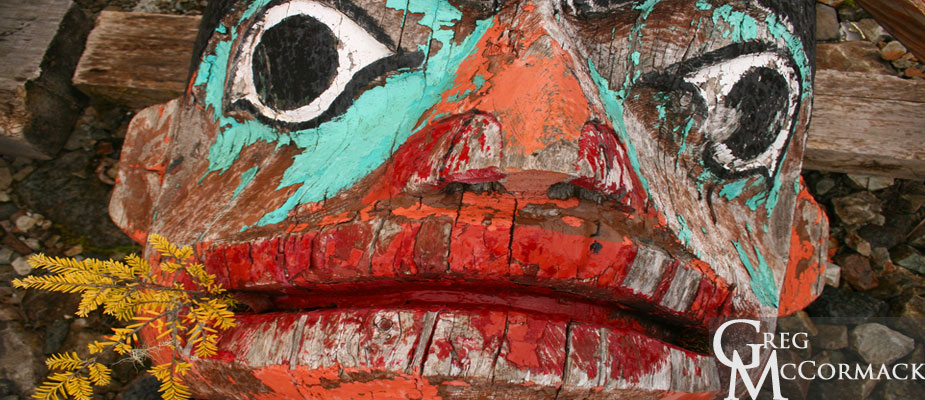
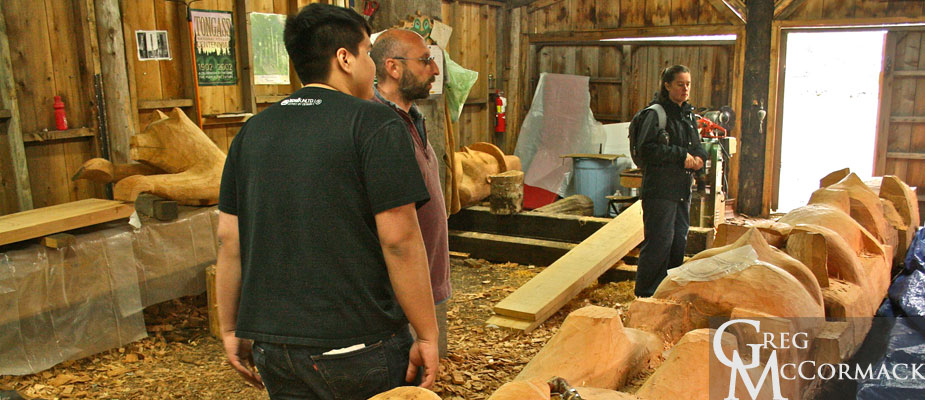
I have a chance to collect a few plants from a friendly home owner, mainly mosses and sapling trees growing out of the side of the driveway and I put them in a temperate rainforest display on the back of the ship. Amazingly, while underway later in the week, an American Dipper flies out from an unmanned island and lands on my display. I’ve seen a Rufous Hummingbird land and a couple of species of seabirds, but never a river dependent avian species like the water ouzel or dipper! Wish I had my camera at that moment!
Grab a few guest passengers and we do a plankton tow at the end of the dock and display them under the 20x and 40x power stereoscopes I have onboard the vessel. Lots of Nauplius or barnacle larvae and tens of thousands of phytoplankters or plant plankton.
Sunday | May 15th
June 26, 2011 by admin
Filed under InnerSea Discoveries
We explore Prince of Wales (POW) Island, the largest in Southeast Alaska, with the dimensions of 135 miles long by 45 miles wide. It has been logged extensively and there are 1000’s of miles of roads with plenty of camping and fish camps available for those that travel from Ketchikan or beyond. POW has almost 1,000 miles of shoreline and numerous lakes in the interior that offer excellent fishing for rainbow, steelhead and cutthroat trout. Towns include: Hydaburg and Thorne Bay, Hollis, Craig and Klawok.
Saturday | May 14th
June 26, 2011 by admin
Filed under InnerSea Discoveries
Ketchikan on another sunny day. Head off the ship to the Cape Fox Lodge for a talk by Tlingit speaker Joe Williams who does a marvelous job of describing clans and marriage and customs of the culturally rich and dynamic Tlingit who have been living in the area for 10,000 years.
We visit a cave that has produced the archaeological evidence that shows that not all of Alaska was beneath ice during the Pleistocene, some areas were ice-free and early peoples thrived.


